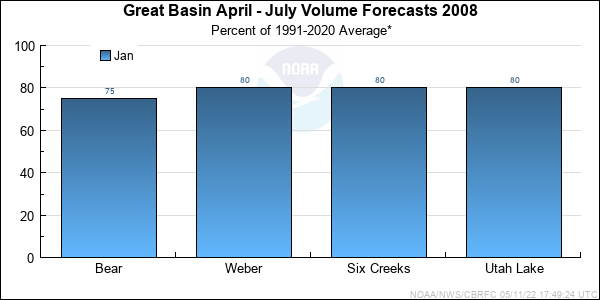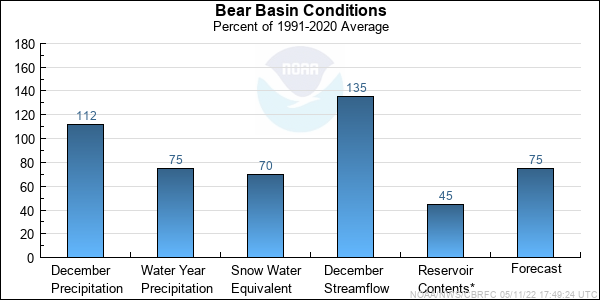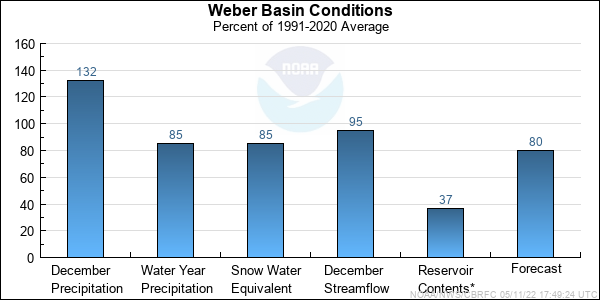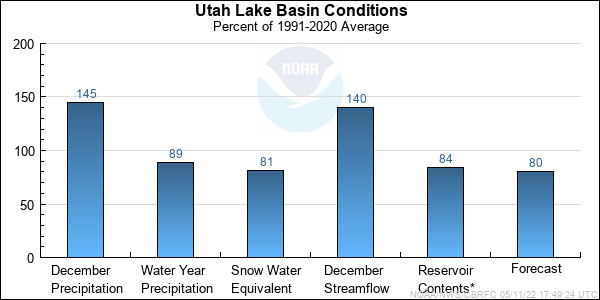
NOAA, National Weather Service
Colorado Basin River Forecast Center
Salt Lake City, Utah
www.cbrfc.noaa.gov
 | Prepared by Brent Bernard NOAA, National Weather Service Colorado Basin River Forecast Center Salt Lake City, Utah www.cbrfc.noaa.gov |





| Forecast Period | 50% Exceedance | Percent Average | 10% Exceedance | 90% Exceedance | |
| Weber | |||||
| Oakley, Nr | April-July | 100 | 81 | 147 | 53 |
| Rockport Res, Wanship, Nr | April-July | 114 | 85 | 180 | 48 |
| Coalville, Nr | April-July | 107 | 78 | 169 | 54 |
| Chalk Ck | |||||
| Coalville | April-July | 34 | 76 | 57 | 11 |
| Weber | |||||
| Echo Res, Echo, At | April-July | 145 | 81 | 215 | 77 |
| Lost Ck | |||||
| Lost Ck Res, Croydon, Nr | April-July | 12 | 68 | 22 | 2.5 |
| East Canyon Ck | |||||
| East Canyon Res, Morgan, Nr | April-July | 25 | 81 | 41 | 13 |
| Weber | |||||
| Gateway | April-July | 290 | 82 | 430 | 154 |
| Sf Ogden | |||||
| Huntsville, Nr | April-July | 42 | 66 | 73 | 11.5 |
| Ogden | |||||
| Pineview Res, Ogden, Nr | April-July | 108 | 81 | 163 | 52 |
| Wheeler Ck | |||||
| Huntsville, Nr | April-July | 3.9 | 62 | 6.9 | 0.9 |
| Forecast Period | 50% Exceedance | Percent Average | 10% Exceedance | 90% Exceedance | |
| Little Cottonwood Ck | |||||
| Salt Lake City, Nr | April-July | 32 | 80 | 44 | 19.8 |
| Big Cottonwood Ck | |||||
| Salt Lake City, Nr | April-July | 34 | 89 | 42 | 18.2 |
| Mill Ck | |||||
| Salt Lake City, Nr | April-July | 5.7 | 81 | 8.5 | 2.9 |
| Dell Fk | |||||
| Little Dell Res | April-July | 5 | 74 | 9.5 | 0.68 |
| Parleys Ck | |||||
| Salt Lake City, Nr | April-July | 12 | 72 | 20 | 2 |
| Emigration Ck | |||||
| Salt Lake City, Nr | April-July | 3.5 | 78 | 7.1 | 0.1 |
| City Ck | |||||
| Salt Lake City, Nr | April-July | 7 | 80 | 11.4 | 2.6 |
| Vernon Ck | |||||
| Vernon, Nr | April-June | 1.4 | 95 | 2 | 0.45 |
| S Willow Ck | |||||
| Grantsville, Nr | April-July | 2.8 | 87 | 4.5 | 1 |
| Forecast Period | 50% Exceedance | Percent Average | 10% Exceedance | 90% Exceedance | |
| Spanish Fork | |||||
| Castilla, Nr | April-July | 65 | 84 | 146 | 24 |
| Provo | |||||
| Woodland, Nr | April-July | 85 | 83 | 119 | 51 |
| Hailstone, Nr | April-July | 88 | 81 | 129 | 47 |
| Deer Ck Res | April-July | 85 | 67 | 151 | 19 |
| American Fork | |||||
| American Fork, Nr, Up Pwrplnt, Abv | April-July | 27 | 84 | 43 | 11.2 |
| Jordan | |||||
| Utah Lake, Provo, Nr | April-July | 260 | 80 | 450 | 70 |
| Usable Capacity | EOM Contents | Percent Usable Capacity | Last Year EOM | Last Year %Capacity | |
|
| |||||
| Lifton, St. Charles, Nr | 1302.0 | 226.0 | 17 | 404.0 | 31 |
|
| |||||
| Causey Res | 7.1 | 37.3 | 525 | 3.1 | 44 |
|
| |||||
| 311.0 | 230.0 | 74 | 258.7 | 83 | |
|
| |||||
| Deer Ck Res | 149.7 | 63.4 | 42 | 133.6 | 89 |
|
| |||||
| East Canyon Res, Morgan, Nr | 49.5 | 27.3 | 55 | 37.3 | 75 |
|
| |||||
| Echo Res, Echo, At | 73.9 | 27.3 | 37 | 48.6 | 66 |
|
| |||||
| Hyrum Res Abv | 15.3 | 10.5 | 69 | 10.5 | 69 |
|
| |||||
| Lost Ck Res, Croydon, Nr | 22.5 | 13.0 | 58 | 16.3 | 72 |
|
| |||||
| Pineview Res, Ogden, Nr | 110.1 | 37.3 | 34 | 60.9 | 55 |
|
| |||||
| Rockport Res, Wanship, Nr | 60.9 | 30.0 | 49 | 39.8 | 65 |
|
| |||||
| Utah Lake, Provo, Nr | 870.9 | 731.3 | 84 | 864.0 | 99 |
|
| |||||
| 215.0 | 51.0 | 24 | 91.7 | 43 | |
|
| |||||
| Woodruff Narrows Res | 55.8 | 24.0 | 43 | 45.5 | 82 |
|
| |||||
| TOTAL | 3243.7 | 1508.4 | 47 | 2014.0 | 62 |
| Range | Round to | |
| 0-1.99 | 0.01 | |
| 2.0-19.9 | 0.1 | |
| 20-199 | 1.0 | |
| 200-999 | 5.0 | |
| 1000+ | 3 significant digits |